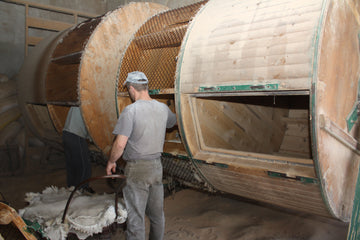Brought to you from traditional tanning cultures, made from sheep of the regions where the flocks began.
What is a genuine sheepskin?
A real sheepskin is a natural leather product, not a fur. It is the leather pelt of a lamb or sheep that was tanned with the fleece intact. An artificial or faux sheepskin is made of acrylic fibers sewn onto a backing – soft strands of bright white plastic. If you don’t immediately see the difference, you certainly will feel it.
The leather tanning process preserves the skin into long-lasting, durable leather. In the case of sheepskins, the wool hairs of the fleece are locked into the structure of the hide. This makes a real sheepskin rug thick and cushy. It’s a dense mass of wool fibers attached to the full size sheepskin pelt.
Sheepskins have served as natural cushion and insulation since our ancestors first began domesticating animals. Sheep and goats were the first herd animals raised when primitive agriculture began. The benefits of natural sheepskins have never been surpassed by synthetic materials. See how the American Wool Council explains the benefits of wool fiber here.

What kinds of sheep are they?
Our webstore is a catalog of natural color sheepskin rugs for sale. The differences reflect a range of heritage breeds. White, brown, gray, spotted, mottled – the colors and fleece patterns show the uniqueness of the breeds.
The shepherds of Iceland have maintained the original stock brought by Viking settlers. The flocks are same long wool Icelandic breed, but the individual sheep have a mix of natural colors. Our spotted sheepskins are the signature look of Jacob sheep from Holland and the UK. The notable gray Herdwick breed, for example, is mainly found in the fells of Northern England. They are unusual sheep raised specifically in Cumbria.

Where are the sheepskin rugs made?
Firstly, let’s ask where the raw hide comes from. The world’s top exporters of lamb and sheep are the meat industries of Australia and New Zealand. Together they dominate about 75% of the world market. The largest importer and consumer is China. Nearly all of the sheepskins you see in big box stores and online originate from this trade.
Our sheepskins, however, start in the niche agriculture of specific parts of Europe. It is the leather byproduct of traditional flocks raised for their meat. Because nearly all British lamb is raised on grass with a high prevalence of small farmers, the Independent newspaper says that UK lamb is the most ethical meat to eat, see article here. Lamb or mutton is common in traditional English cuisine. It is also in high demand among immigrant communities. In Iceland, it’s the most common meat on the dinner plate after fish.
The second important question is where the leather tanning was done. According the US Customs law, a leather item is considered to be made in the country where the raw hide is transformed into the final product. So the country of origin on the product is where the leather tannery is located. In our case, the sheepskins come from the traditional tanning culture of Central Europe. They are made in Poland where sheepskins have been used for clothing and general household use since the middle ages. Thick sheepskin coats, hats, gloves and boots are the traditional garb of the Carpathian Mountains.

Eco-tanning, small batch.
Small batch, traditional tanners make our sheepskins using eco-friendly methods. In Europe, the term eco-tanning refers to an approach with reduced chemicals and salts, chromium-free processes, efficient water conservation, and management of waste. The processing time is longer with additional steps. However, a smaller footprint strengthens a stable, sustainable trade for the long term.
Contrast this to the factory style processing in Asia with little oversight and a poor environmental record. The European Union regulations for leather are among the strictest. For more information, see the latest Social and Environmental Report for the European leather industry here.

Real sheepskins, authentic experience.
From the regions where the sheep are raised, to the traditions where they are tanned, these are the real genuine sheepskins of Europe. They are the same sheepskin rugs you'll find in the famous holiday markets of Germany and Scandinavia. When you buy sheepskins from us, you support the shepherds who maintain Europe’s remaining heritage breeds and the traditional tanneries who have maintained their craft through generations.
If you're still not convinced that you'll be satisfied, we have a Quality Guarantee with return shipping. With the high cost of shipping nowadays, we don’t expect you’ll send it back. Whether as a cozy couch cushion or a soft rug next to the bed, a sheepskin is always satisfying.
